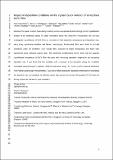| dc.contributor.author | Khoo, Chee Ying | |
| dc.contributor.author | Liu, Hai | |
| dc.contributor.author | Sasangka, Wardhana A. | |
| dc.contributor.author | Made, Riko I. | |
| dc.contributor.author | Tamura, Nobu | |
| dc.contributor.author | Kunz, Martin | |
| dc.contributor.author | Budiman, Arief S. | |
| dc.contributor.author | Gan, Chee Lip | |
| dc.contributor.author | Thompson, Carl Vernette | |
| dc.date.accessioned | 2016-06-27T15:44:42Z | |
| dc.date.available | 2017-03-01T16:14:47Z | |
| dc.date.issued | 2015-10 | |
| dc.date.submitted | 2015-06 | |
| dc.identifier.issn | 0022-2461 | |
| dc.identifier.issn | 1573-4803 | |
| dc.identifier.uri | http://hdl.handle.net/1721.1/103352 | |
| dc.description.abstract | The speed at which phase change memory devices can operate depends strongly on the crystallization kinetics of the amorphous phase. To better understand factors that affect the crystallization rate, we have investigated crystallization of GeTe films as a function of their deposition temperatures and deposition rates, using X-ray synchrotron radiation and Raman spectroscopy. As-deposited films were found to be fully amorphous under all conditions, even though films deposited at higher temperatures and lower rates experienced lower effective quench rates. Non-isothermal transformation curves show that the apparent crystallization temperature of GeTe films decreases with increasing deposition temperature and decreasing deposition rate. It was found that this correlates with a decrease in the activation energy for nucleation (calculated using Kissinger’s analysis), while the activation energy for crystal growth remained unaffected. From Raman spectroscopy measurements, it was found that increasing the deposition temperature or decreasing the deposition rate, and therefore the effective quench rate, reduces the number of homopolar Te–Te bonds and thereby reduces the barrier to crystal nucleation. | en_US |
| dc.description.sponsorship | Singapore-MIT Alliance for Research and Technology (SMART) | en_US |
| dc.publisher | Springer US | en_US |
| dc.relation.isversionof | http://dx.doi.org/10.1007/s10853-015-9493-z | en_US |
| dc.rights | Creative Commons Attribution-Noncommercial-Share Alike | en_US |
| dc.rights.uri | http://creativecommons.org/licenses/by-nc-sa/4.0/ | en_US |
| dc.source | Springer US | en_US |
| dc.title | Impact of deposition conditions on the crystallization kinetics of amorphous GeTe films | en_US |
| dc.type | Article | en_US |
| dc.identifier.citation | Khoo, Chee Ying, Hai Liu, Wardhana A. Sasangka, Riko I. Made, Nobu Tamura, Martin Kunz, Arief S. Budiman, Chee Lip Gan, and Carl V. Thompson. “Impact of Deposition Conditions on the Crystallization Kinetics of Amorphous GeTe Films.” Journal of Materials Science 51, no. 4 (October 20, 2015): 1864–1872. | en_US |
| dc.contributor.department | Massachusetts Institute of Technology. Department of Materials Science and Engineering | en_US |
| dc.contributor.mitauthor | Thompson, Carl Vernette | en_US |
| dc.contributor.mitauthor | Khoo, Chee Ying | en_US |
| dc.contributor.mitauthor | Gan, Chee Lip | en_US |
| dc.relation.journal | Journal of Materials Science | en_US |
| dc.eprint.version | Author's final manuscript | en_US |
| dc.type.uri | http://purl.org/eprint/type/JournalArticle | en_US |
| eprint.status | http://purl.org/eprint/status/PeerReviewed | en_US |
| dc.date.updated | 2016-05-23T12:15:34Z | |
| dc.language.rfc3066 | en | |
| dc.rights.holder | Springer Science+Business Media New York | |
| dspace.orderedauthors | Khoo, Chee Ying; Liu, Hai; Sasangka, Wardhana A.; Made, Riko I.; Tamura, Nobu; Kunz, Martin; Budiman, Arief S.; Gan, Chee Lip; Thompson, Carl V. | en_US |
| dspace.embargo.terms | N | en |
| dc.identifier.orcid | https://orcid.org/0000-0002-0121-8285 | |
| mit.license | OPEN_ACCESS_POLICY | en_US |
| mit.metadata.status | Complete | |
